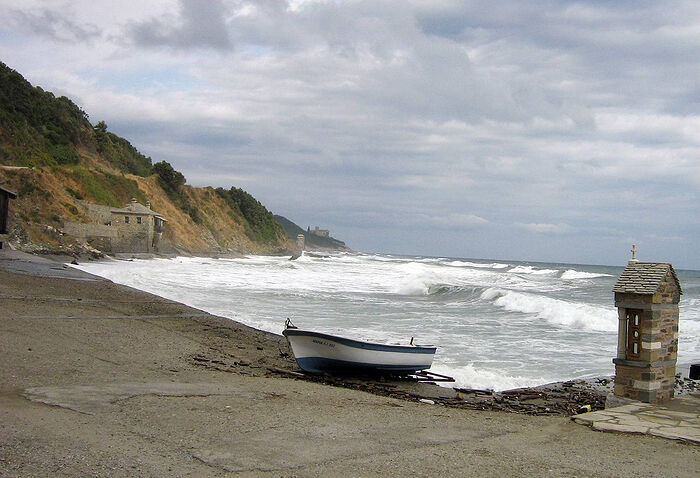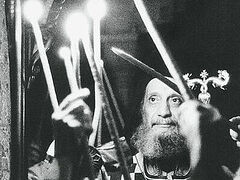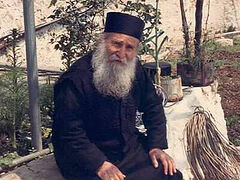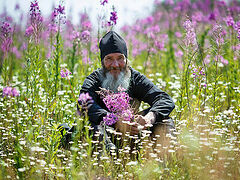THE SECOND CASE
August 25th, Saturday, about 3 pm
Dormition fast. Commemoration of the Holy Martyrs Photios and Anicetus and those with them (305–306 AD).
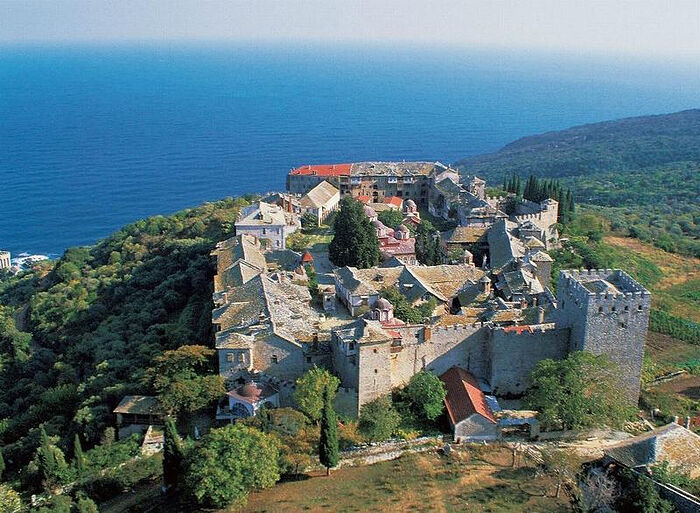 The Great Lavra of Athanasius of Athos
The Great Lavra of Athanasius of Athos
That’s how it went. Having spent the night in Karakallou, I rushed off bright and early to the Great Lavra of Athanasius of Athos to get the “Scarlet Flower.” The monastery is famous for a special kind of holy water and I wanted to get it as a present for my wife.
However, the road trip went so well that, having found what I wanted in the Lavra, I made it by lunchtime to Karyes, the capital of the Holy Mountain.
Since I was “armed” with two video cameras, I cherished the hope of recording a conversation with Archimandrite Jonah (Ignatenko). He had just arrived on Mt. Athos from Odessa to pray. It meant we had no time to waste, but to travel to our Russian St. Panteleimon Monastery. The faster we got there, the better. I had enough time and felt strong enough, so I set off on foot again. I went straight across the mountain pass.
***
There is such an interesting place there—when you go up from St. Andrew’s Skete and pass over the ridge, the dirt road will take you down to the western coast of Mount Athos. To the place where our monastery sits, nestled cozily next to the bay shore. That’s where you have to pass through the so-called “tunnel” formed by the overlapping crowns of tall chestnut trees growing on both sides of the road.
It was getting dark already, but the sun was still high. I walked completely alone, slightly swinging my prayer beads in the air. My mouth wearily mumbled the Jesus Prayer, while my eyes curiously scanned the surrounding nature. My feet easily moved down the slope, and I keenly waited for a chance to visit the famous Old Rusicon skete.
It can hardly be called the cradle of the Russian presence on the Holy Mountain, but it surely was “destination number two.” It was where the center of Russian monasticism on Mount Athos gradually moved from the dense backwoods of the Xylurgu skete. A little later, it moved even further towards the sea—directly to its own landing place where, over time, it expanded to become a great and beautiful monastery. But here, in Old Rusicon, silence and prayerful peace has been restored once again. It became a skete.
 A place looking similar to the location of the Second Case
A place looking similar to the location of the Second Case
I never visited it and, as I was walking through the “tunnel”, I expected to see it ahead of me at the end of the road.
But then, all of a sudden, (!) I felt it again: a man was standing invisibly to my left, and the censer in his hand was flying straight towards my face!
And again, it felt just the same—the delicious smell of incense, the heat and the smell of burning coal!
I looked round in desperation, but like before, I saw no one. The chestnut alley was completely deserted.
So, I waited a little, looking around, then collected myself a bit and continued on my way. What else was I supposed to do?..
Once I walked past the Old Rusicon and the little mill of St. Silouan the Athonite, I arrived to the coast.
“That’s it,” I decided, “from now on, I am going to carry my camera “fit for action” on my chest!”
I remembered how several times my friends and I had unexpectedly discovered on their snapshots certain things that our eyes didn’t see when we were taking a picture—human silhouettes, odd-looking clouds, etc. Moreover, it happened with both film and digital cameras.
***
By the way, the Russian St. Panteleimon’s monastery where I was heading has been itself a great example of such events. As you walk up the stairs towards the arched seaward passage that takes you inside the monastery, you can see a large photograph on the wall to the left of the arch. It depicts an amazing event that took place next to the gates here in 1903.
Back then, the monks of the monastery had the custom of distributing alms after Liturgy to their fellow mendicant monks who had no place to live on Mount Athos. They are called the “Syromakhi” here. They sat near the entrance to the monastery humbly asking for alms. The Protaton of the Holy Mountain, moved by a worthy desire to stop the welfare dependency, demanded that the Russian monastery stop this “pernicious practice.”
When he printed the photograph, he was surprised to see a Woman among the Syromakhs...
Then came the last day, when the Russian monks were obliged to obey the order of the Athonite leadership. They gave alms and left to perform their obedience. But it so happened that one of the monks made a photo of the final alms distribution. When he developed the photographic plate and printed the photo, he was surprised to see… a Woman among the Syromakhs, who reverently and humbly held bread that she has just received from the hands of a pious Russian monk. Probably, it is superfluous to say that the photographer didn’t see the Most Holy Mother of God when he was taking this photo either.
The photo of the Abbess of Mount Athos, and most importantly, the hidden meaning of this photo influenced the members of the Holy Synod so strongly that they immediately annulled their decision.
***
There is a large monastery icon shop next to the Holy Gate to the right inside the archway. That year, Hieromonk Isidore (Berezhnoy) was a senior monk there. During my previous visits, we got to know one another and I immediately “spilled” all my excitement on him.
“Listen, Sergiy,” he answered, not a bit surprised. “Either this had something to do with those twenty-four invisible elders, or you walked by the burial places of some of the unknown saints. And the fragrance you felt was emanating from their relics.”
“Hmmm,” I wondered, “how does the hot censer that flew several times right to my nose fit into this “perspective?”
“You know, Fr. Silouan the Athonite,” continued Fr. Isidore, “described such an incident. When he was once deep inside the Athonite thicket, he came to an abandoned cell. It was obvious that no one had lived there for a long time, and its walls even collapsed at some places. And only the subtle fragrance of heavenly sweetness filled the surroundings as an indication that this place was marked by the special Grace of God. He went to search thoroughly in order to find the source of this wondrous fragrance and soon found it. His search brought him to two grave mounds.
The crosses above them had fallen down a long time ago. It became clear to him that the fragrance was emanating from underground. It meant the monks buried there were surely vouchsafed holiness by the Lord.
Fr. Silouan wanted to uncover the holy relics of these righteous men, but the day was drawing to a close and it was getting too late. Deciding to fulfill his plan in the morning, he went to the second floor, prepared a bed for the night and went to sleep.
However, during the night our saint had a dream where two unfamiliar monks appeared to him and strictly forbade touching their graves, as they are categorically against his plan. As he woke from his sleep, Fr. Silouan bowed down in front of their graves and humbly left the cell.
It became clear to him that the fragrance was emanating from underground
“Fr. Isidore,” I asked, “but yesterday one person explained this strange phenomenon in a different way. He said it was the smell of incense production waste.”
“Nonsense! There is no such thing as incense production waste. We produce our own incense in the monastery and I know for a fact that we recycle absolutely everything!”
THE THIRD CASE
September 2nd, Sunday, about 7 a.m.
No fasting. Commemoration of Prophet Samuel, Martyrs Severus, Memnon and 37 soldiers (304). Icon of the Mother of God, “Increase of Mind”
My month-long stay on Mount Athos was coming to an end. I had reorganized my plans so that I was already moving closer to the “exit line,” that is, from the south to the north and towards the harbor in Giannitsa. However, how can you ever talk about some plans of your own while on Mount Athos?
That’s why, early in the day, after I spent the night in the Greek monastery of Karakallou, I set off on foot towards Karyes. I was hoping to reach the Vatopedi monastery by the evening in an attempt to record an interview with Elder Joseph of Vatopedi! But in order to do that, I had to walk along the eastern shore of the peninsula to the monastery of Iveron first and then on to Karyes. Once there, I’d have to catch some shuttle bus going to Vatopedi.
And off I went. Trailing close behind me on my way to Karyes was one of the Albanian construction workers—the Athonite monasteries had quite a lot of them at that time. Overall, the presence of Albanian Muslims on Orthodox Athos is a particularly special topic. I later saw this particular Albanian, who went after me, in Karyes, when a shuttle bus arrived from the port of Daphne. He was meeting about fifteen of his young compatriots who arrived there by ferry. He was probably taking them back to Karakallou.
***
That morning turned out to be somber and gloomy, with a rather strong easterly wind blowing from the sea. The road snaked around the twists of the hilly area—it would emerge forward exposing itself to the sea and wind in one place only to turn inland next and hide from them inside a long circular bend. It was quiet and calm there, with only a soft wind playing in the trees.
The Albanian tactfully stayed behind keeping a distance of about thirty meters: If I slowed down, he would slow down too, and if I went faster, he’d go faster, too. We walked together this way for quite some time now. I was quietly reading the prayer rule, except that I kept my prayer beads in front of me, hiding them from the Albanian.
![The location of the third case. Inset in the photo: [A man was standing around this spot]](https://pravoslavie.ru/sas/image/104277/427782.p.jpg?mtime=1703591384) The location of the third case. Inset in the photo: [A man was standing around this spot]
The location of the third case. Inset in the photo: [A man was standing around this spot]
There were still a few kilometers left before Iveron Monastery, when the road zigzagged once again and dipped inside the mountain gorge, away from the sea. Here, inside a small ravine, despite the raging storm on the Aegean Sea and the howling wind at the water’s edge, everything was absolutely calm and quiet. The only sound interrupting it was the soft rustling of the pebble gravel of the road underfoot.
I walked past a small bridge. A small creek was running down toward the sea with a light rumbling. My camera was hanging around my neck—I carried it ever since I had that incident. A steep mountain wall stretched to my left, and to the right, there was a small overgrown slope that led down to the creek.
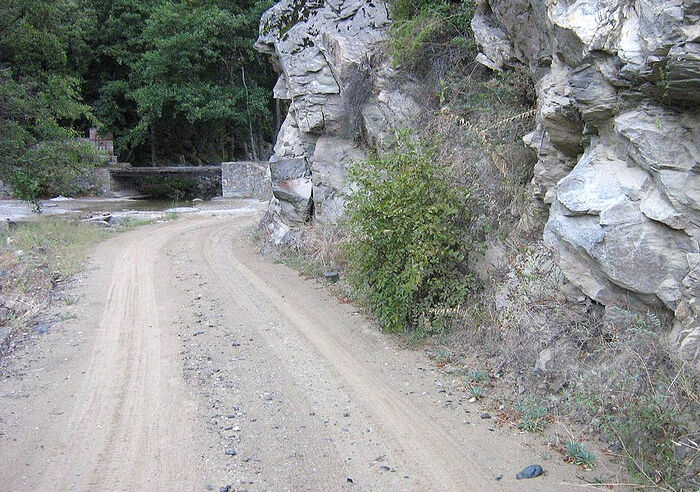 The location of the third case. The view from the back
The location of the third case. The view from the back
Suddenly (!) I sensed it again: To my left, beside the mountain wall, a man was standing invisibly, and the censer in his hands again flew right up to my face!
And here it was again—that overwhelming and incredibly beautiful fragrance of incense, and that heat and smell of burning coal!!!
“Well, you won’t get away from me now,” I screamed feverishly in my mind and grabbed my camera in a thrill of pursuit!
Using flash and turning it off, I photographed every single centimeter in my immediate vicinity!
Immediately afterwards, I carefully examined the footage by using zoom. Absolutely nothing! Nothing at all... Empty... Nothing but the road, stones, and rocks...
The Muslim stopped and tactfully, but inquisitively observed my “shenanigans” from afar. He probably enjoyed it:
“This Russian is such a funny guy,” was what he was probably thinking.
CONCLUSION
So, what was it all about? What was it for? What was the hidden meaning of what was entrusted to me by Someone? It was as if I was allowed to peek through a keyhole inside a hidden and inaccessible world of the Holy Spirit! What for? To convince me that God exists? But I already had an ironclad knowledge of that for eleven years.
It was as if I was allowed to take a peek behind the door into the world of the Holy Spirit, mysterious and inaccessible for us!
The only reasonable theory that comes to my mind today is as follows: such obvious unveiling of the spiritual world before me served only one purpose—to change my spiritual priorities, to pull me away from the excessive fascination with church politics, the endless fanatical struggle against globalization and apostasy, and to literally have me fall in love with the quiet, inner spiritual work, displaying its power and spiritual beauty.
Orthodoxy has two kinds of activity: external and internal. Coming to the Church as neophytes, and particularly if we are loaded down with the past as “combative” Komsomol and Party members, we are more inclined to do the external work: to fight for the purity of the teachings of faith or against “liquid” and “solid” microchips, or 5G cellular networks. We also love huge cross processions, prayer vigils (that often end up in hysteria), collecting signatures for any cause, all kinds of petitions and appeals. We adore our Theophany dips in forty-degree freezing weather; we never miss our chance to “raise our voice” (with or without any specific reason); we sermonize and enlighten others.
In short, it is the external “actions” that we are most eagerly looking for in the Church! Many of us also consider this the true life of the Church.
Sure, many of the things mentioned above have to do with the Church (directly or indirectly), but if taken only in reasonable proportions, I think. This is just a frame, a background for something much more important and fundamental—doing the work of the heart: self-transformation of your inner state, your eternal and immortal soul. Doing this to get rid of sinful tendencies and habits.
The most important instruments in this process are not the number of churches you have built (which, of course, is great!), but the regular and frequent participation in the Church sacraments and the innermost, daily labor of prayer. Above all, the use of the Jesus Prayer. Alas! Only these two factors can bring our proud, “enlightened” and “self-sufficient” mind back home—to our heart...
***
Anyway, I slung my heavy backpack and, lost in thought, continued on my way.
I was embarrassed and confused—I had come to Athos for support, but encountered this instead! One of the most stubborn anti-globalization activists in Russia, I now doubted my rightness for probably the first time in many years. Just a tiny bit... Ever so slightly...
Who knows, what if this became the fourth—and the most unexpected and the most important miracle for me!!!
***
The sky gradually began to lighten and life moved on. My Albanian “bodyguard” was following me again like a shadow. Iveron was not too far from us...


